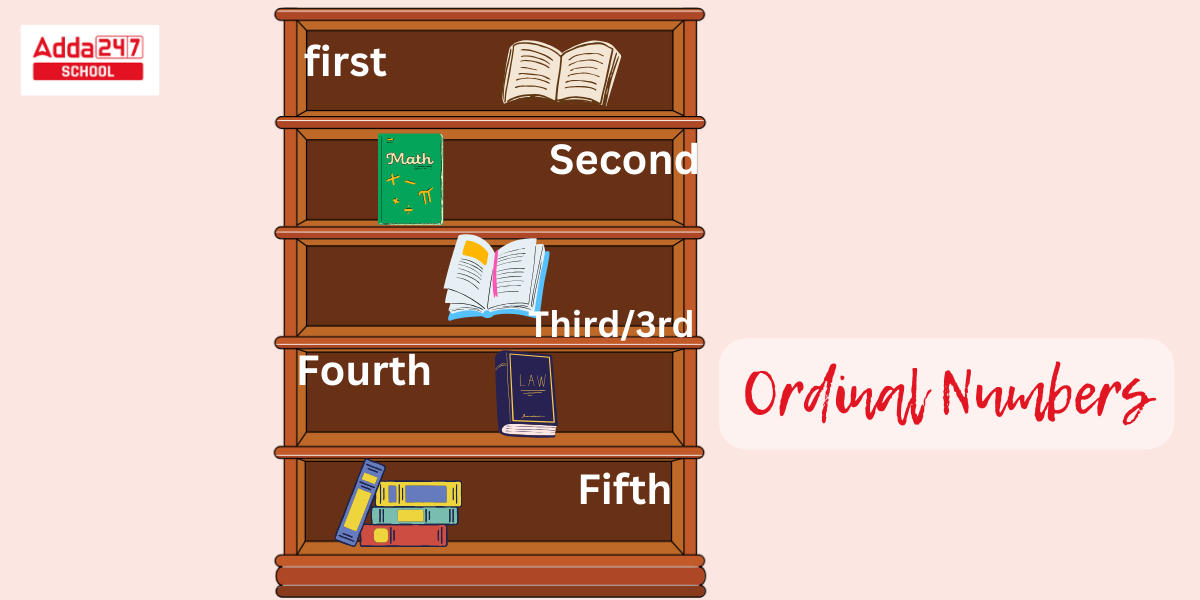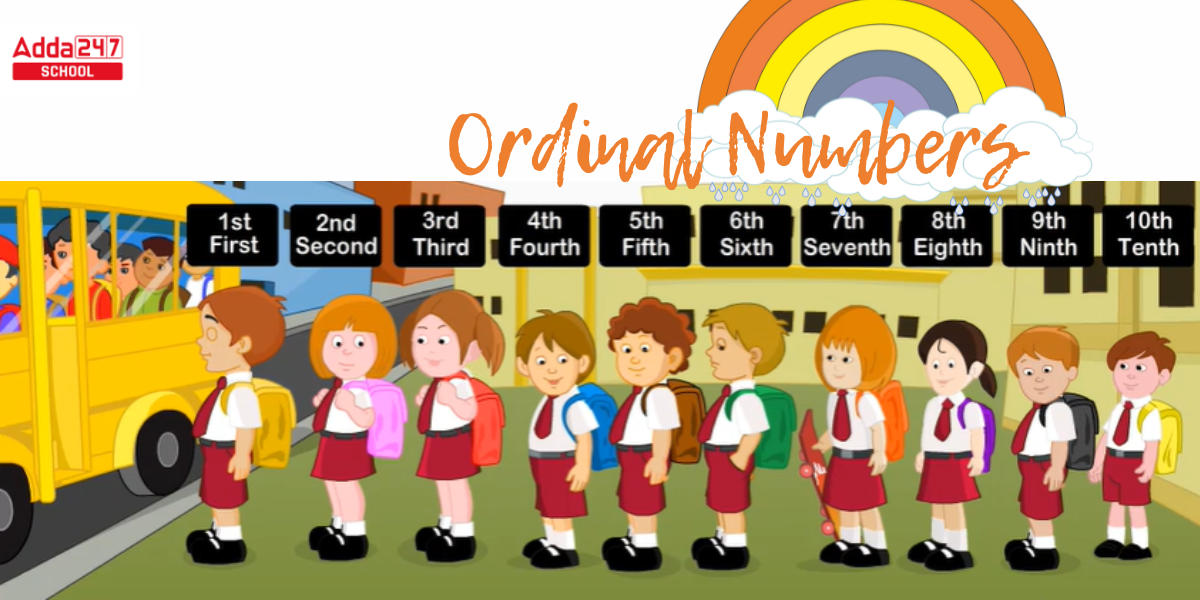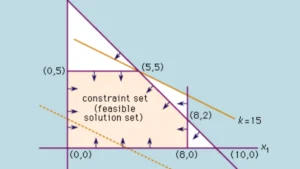Table of Contents
Ordinal numbers are numbers that describe the position or rank of things, or how we organize them, such as first, second, third, and so on. This order or sequence could be determined by size, importance, or chronology. Ordinal numbers can be expressed with numerals as prefixes and adjectives as suffixes, such as first, second, third, fourth, fifth, sixth, and so on. The fundamental feature that distinguishes an ordinal number is that it discusses positioning. Read the entire article to learn more about ordinal numbers.
Ordinal Numbers
Let’s look at an example to better comprehend ordinal numbers. A quiz contest was attended by 15 students. The top three winners received medals and were ranked first, second, and third. The places 1st, 2nd, and 3rd are ordinal numbers in this situation. The sequence of ordinal numbers varies depending on the parameters that are dependent on the defined places, such as weight, height, marks, size, and so on. Ordinals are another name for such numbers.
Another example is ‘The 4th one from the right attire is beautiful’, and ‘The old books are kept in 3rd box from the left’. All of these statements have one thing in common: they discuss object placements.
How to write Ordinal Numbers?
An ordinal number is a number that specifies how something ranks with respect to other numbers, such as first, second, third, and so on.
- If an ordinal number refers to placement, we can simply recognize it. For example, we may write it as first, second, third, fourth, fifth, sixth, seventh, eighth, and so on.
- So, if we say, “Bring me the book that’s on the third shelf,” we’d know that the ordinal number here is 3, which tells us about the book’s location in the library. The image below depicts various selves in a book.
- We may utilize ordinal numbers to determine the location of the books in this case. The numbers 1st (first), 2nd (second), 3rd (third), 4th (fourth), and 5th (fifth) indicate the order of the books in the bookshelf. As a result, they are all ordinal numbers.

Ordinal Numbers Application & Example
Ordinal numbers, also known as ordinals, are composed of numerals as prefixes and adjectives as suffixes.
- If we want to know the order of dates or the order of things, we should use ordinal numerals. Example – 4th week of August.
- Ordinal numbers should only be used when you have access to the data and wish to arrange it in some manner. For example, we might state that the person who attempted the paper did so in an exceptional and skillful manner. The one who performed better but not as well as the first placed second, while the one who performed the poorest placed last in the class.
- Ordinal numbers can be used to identify the location of specific things or people from a list.
- For example, we can use ordinal numbers to say that Vedika always comes first/1st in the long jump. The ordinal number 1st indicates the rank that Vedika has obtained.
- Aditya is in the fourth position in the line. We may deduce Aditya’s position in the queue from the ordinal number 4th.
- A swimming pool is located in the 15th Building. The ordinal number 15th here refers to the Building that has its own swing pool.
Ordinal Numbers and Cardinal Numbers
Cardinal numbers are numbers that can be used to count real items or things. They’re sometimes referred to as “counting numbers” or “cardinals.” This number type is used to express the cardinality of the number of items in a set. We frequently utilize cardinal numbers or cardinals to answer questions that begin with “How many?” Cardinal numbers can be natural numbers that we employ for counting, such as one, two, three, four, and five.
Ordinal numbers, on the other hand, are employed to determine the rank or position of anything or a person. Ordinal numbers are written with numbers as prefixes and adjectives as suffixes.
Example – Let us illustrate the distinction between ordinal and cardinal numbers with an example. Some kids were assigned to draw birds.
-
- Sita drew one artwork, Jay drew two, and Kiara drew three. The digits 1, 2, and 3 are cardinal numbers because they reflect the total number of drawings made.
- The person who draws the most birds now wins. So, Kiara is first, Jay is second, and Sita is third. The numerals 1st, 2nd, and 3rd are ordinal numbers because they represent the students’ positions.
Ordinal Numbers 1 to 10
Ordinal numbers represent a position or rank in a sequential order. Here are the ordinal numbers from 1 to 10:
- First (1st)
- Second (2nd)
- Third (3rd)
- Fourth (4th)
- Fifth (5th)
- Sixth (6th)
- Seventh (7th)
- Eighth (8th)
- Ninth (9th)
- Tenth (10th)
These are used to indicate the order of objects or people, like ‘first place’ in a race, ‘second floor’ in a building, or ‘tenth in line’ at a store.
Ordinal Numbers 1 to 20- Ordinal Numbers from 1 to 20
Ordinal numbers 1 to 20 are different from the others. A recurring pattern of ordinal numerals can be seen after the number 20. 1 means first, 2 means second, and 3 means third. 4th, 5th, 6th, 7th, 8th, 9th, 10th, 11th, 12th, 13th, 14th, 15th, 16th, 17th, 18th, 19th, and 20th. The following chart depicts ordinal numbers 1 to 20.
| Ordinal Numbers From 1 to 20 | |
| 1st: First | 11th: Eleventh |
| 2nd: Second | 12th: Twelfth |
| 3rd: Third | 13th: Thirteenth |
| 4th: Fourth | 14th: Fourteenth |
| 5th: Fifth | 15th: Fifteenth |
| 6th: Sixth | 16th: Sixteenth |
| 7th: Seventh |
17th: Seventeenth
|
| 8th: Eighth | 18th: Eighteenth |
| 9th: Ninth | 19th: Nineteenth |
| 10th: Tenth | 20th: Twentieth |
Ordinal Numbers 1 to 30
Here are ordinal numbers from 1 to 30 is given below this table.
| Ordinal Numbers 1 to 30 | |
| 1st: First | 16th: Sixteenth |
| 2nd: Second | 17th: Seventeenth |
| 3rd: Third | 18th: Eighteenth |
| 4th: Fourth | 19th: Nineteenth |
| 5th: Fifth | 20th: Twentieth |
| 6th: Sixth | 21st: Twenty-One |
| 7th: Seventh | 22nd: Twenty-Second |
| 8th: Eighth | 23rd: Twenty Third |
| 9th: Ninth | 24th: Twenty fourth |
| 10th: Tenth | 25th: Twenty Fifth |
| 11th: Eleven | 26th: Twenty Six |
| 12th: Twelfth | 27th: Twenty Seven |
| 13th: Thirteenth | 28th: Twenty Eight |
| 14th: Fourteenth | 29th: Twenty Nine |
| 15th: Fifteenth | 30th: Thirty |
Ordinal Numbers 1 to 50 List
The set of ordinal numbers 1 to 50 is simple to memorize and extremely useful for defining the order of a particular item. You can use the combinations on this list to discover the ordinal numbers from 100 onwards, and we’ve also included the rest of the ordinal Numbers Chart. Read the table below to comprehend how ordinal numbers are expressed.
| Ordinal Numbers Chart 1 to 50 | |
| 1st: First |
26th: Twenty-Sixth
|
| 2nd: Second |
27th: Twenty-Seventh
|
| 3rd: Third |
28th: Twenty-Eighth
|
| 4th: Fourth |
29th: Twenty-Ninth
|
| 5th: Fifth |
30th: Thirtieth
|
| 6th: Sixth |
31st: Thirty-First
|
| 7th: Seventh |
32nd: Thirty-Second
|
| 8th: Eighth |
33rd: Thirty-Third
|
| 9th: Ninth |
34th: Thirty-Fourth
|
| 10th: Tenth |
35th: Thirty-Fifth
|
| 11th: Eleventh |
36th: Thirty-Sixth
|
| 12th: Twelfth |
37th: Thirty-Seventh
|
| 13th: Thirteenth |
38th: Thirty-Eighth
|
| 14th: Fourteenth |
39th: Thirty-Ninth
|
| 15th: Fifteenth | 40th: Fortieth |
| 16th: Sixteenth |
41st: Forty-First
|
| 17th: Seventeenth |
42nd: Forty-Second
|
| 18th: Eighteenth |
43rd: Forty-Third
|
| 19th: Nineteenth |
44th: Forty-Fourth
|
| 20th: Twentieth |
45th: Forty-Fifth
|
| 21st: Twenty-First |
46th: Forty-Sixth
|
| 22nd: Twenty-Second |
47th: Forty-Seventh
|
| 23rd: Twenty-Third |
48th: Forty-Eighth
|
| 24th: Twenty-Fourth |
49th: Forty-Ninth
|
| 25th: Twenty-Fifth | 50th: Fiftieth |
Ordinal Numbers 1 to 100 List
We included all ordinal numbers 1 to 100 as they are required when giving a date in English.
After reviewing the first twenty ordinal numbers, you can notice a trend. In English, the ordinal numbers 1 to 100 are:
| Ordinal Numbers 1 to 100 | ||||
| 1st: First | 21st: Twenty-First | 41st: Forty-First | 61th: Sixty-First | 81st: Eighty-First |
| 2nd: Second | 22nd: Twenty-Second | 42nd: Forty-Second | 62nd: Sixty-Second | 82nd: Eighty-Second |
| 3rd: Third | 23rd: Twenty-Third | 43rd: Forty-Third | 63rd: Sixty-Third | 83rd: Eighty-Third |
| 4th: Fourth | 24th: Twenty-Fourth | 44th: Forty-Fourth | 64th: Sixty-Fourth | 84th: Eighty-Fourth |
| 5th: Fifth | 25th: Twenty-Fifth | 45th: Forty-Fifth | 65th: Sixty-Fifth | 85th: Eighty-Fifth |
| 6th: Sixth | 26th: Twenty-Sixth | 46th: Forty-Sixth | 66th: Sixty-Sixth | 86th: Eighty-Sixth |
| 7th: Seventh | 27th: Twenty-Seventh | 47th: Forty-Seventh | 67th: Sixty-Seventh | 87th: Eighty-Seventh |
| 8th: Eighth | 28th: Twenty-Eighth | 48th: Forty-Eighth | 68th: Sixty-Eighth | 88th: Eighty-Eighth |
| 9th: Ninth | 29th: Twenty-Ninth | 49th: Forty-Ninth | 69th: Sixty-Ninth | 89th: Eighty-Ninth |
| 10th: Tenth | 30th: Thirtieth | 50th: Fiftieth | 70th: Seventieth | 90th: Ninetieth |
| 11th: Eleventh | 31st: Thirty-First | 51st: Fifty-First | 71st: Seventy-First | 91st: Ninety-First |
| 12th: Twelfth | 32nd: Thirty-Second | 52nd: Fifty-Second | 72nd: Seventy-Second | 92nd: Ninety-Second |
| 13th: Thirteenth | 33rd: Thirty-Third | 53rd: Fifty-Third | 73rd: Seventy-Third | 93rd: Ninety-Third |
| 14th: Fourteenth | 34th: Thirty-Fourth | 54th: Fifty-Fourth | 74th: Seventy-Fourth | 94th: Ninety-Fourth |
| 15th: Fifteenth | 35th: Thirty-Fifth | 55th: Fifty-Fifth | 75th: Seventy-Fifth | 95th: Ninety-Fifth |
| 16th: Sixteenth | 36th: Thirty-Sixth | 56th: Fifty-Sixth | 76th: Seventy-Sixth | 96th: Ninety-Sixth |
| 17th: Seventeenth | 37th: Thirty-Seventh | 57th: Fifty-Seventh | 77th: Seventy-Seventh | 97th: Ninety-Seventh |
| 18th: Eighteenth | 38th: Thirty-Eighth | 58th: Fifty-Eighth | 78th: Seventy-Eighth | 98th: Ninety-Eighth |
| 19th: Nineteenth | 39th: Thirty-Ninth | 59th: Fifty-Ninth | 79th: Seventy-Ninth | 99th: Ninety-Ninth |
| 20th: Twentieth | 40th: Fortieth | 60th: Sixtieth | 80th: Eightieth | 100th: Hundredth |
Difference Between Cardinal, Nominal, and Ordinal Numbers
Ordinal numbers are an extension of the natural number idea that is widely used to explain a method of arranging a collection of objects one after the other. For example, our office is on the sixth floor.
Cardinal numbers are natural numbers that we utilise while counting.They are as follows: one, two, three, four, five, six, seven, eight, nine, and ten.
For example, ten men are standing in a row.
Nominal numbers are the numbers used to identify the objects in a group. It is simple to figure out objects or a thing in a collection of things using these numbers.
For example, our flat’s Fat no. is 742.
Pin codes for various cities in India.
Ordinal Numbers Worksheet
Here you can practice some sample questions related to Ordinal Numbers and can see the solution as well.
Example 1: Amaira, Monisa, Dampi, and Jimin are PT students who are standing in a row in the given order. Who is the third person?
Solution – Dampi is in third place if Amaira, Monisa, Dampi, and Jimin are standing in the provided order.
Example 2: Write the ordinal numbers one through ten.
Solution – The ordinal numbers from one to ten are as follows:
|
Ordinal Numbers 1 to 10
|
| 1st – First |
| 2nd – Second |
| 3rd – Third |
| 4th – Fourth |
| 5th – Fifth |
| 6th – Sixth |
| 7th – Seventh |
| 8th – Eighth |
| 9th – Ninth |
| 10th – Tenth |
Example 3: What is the 14th letter of the English alphabet?
Solution – The answer is M, which is the 14th letter of the alphabet.
Example 4: Teachers’ Day is celebrated on September _____.
Solution: Teachers’ Day is on September 5th.



 Greater Than and Less Than, Equal to Sig...
Greater Than and Less Than, Equal to Sig...
 Class 12 Mathematics Linear Programming ...
Class 12 Mathematics Linear Programming ...
 NCERT Solutions Maths Chapter 4 Determin...
NCERT Solutions Maths Chapter 4 Determin...










